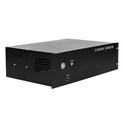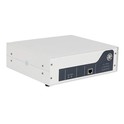As a supplier of ResoLab lab grade ultrasonicator, I am often asked whether our products can be used for ultrasonic cleaning in a laboratory. In this blog post, I will delve into this question, exploring the capabilities of our ResoLab ultrasonicator models and their suitability for laboratory ultrasonic cleaning applications.
Understanding Ultrasonic Cleaning in a Laboratory
Ultrasonic cleaning is a widely used technique in laboratories for removing contaminants from various objects, such as glassware, surgical instruments, and electronic components. The process relies on the creation of high - frequency sound waves in a liquid medium, typically water with a cleaning agent. These sound waves generate microscopic bubbles through a phenomenon called cavitation. When these bubbles collapse near the surface of the object being cleaned, they create powerful shockwaves that dislodge dirt, grease, and other contaminants.
In a laboratory setting, ultrasonic cleaning offers several advantages. It is a non - abrasive method that can reach areas that are difficult to access manually. It is also a time - efficient process, capable of cleaning multiple items simultaneously. Moreover, it can be adjusted to suit different types of materials and contaminants, making it a versatile cleaning solution.
Features of ResoLab Lab Grade Ultrasonicator
Our ResoLab ultrasonicator series, including the ResoLab - 500 Lab Grade Ultrasonicator, ResoLab - 1000 Lab Grade Ultrasonicator, and ResoLab - 2000 Lab Grade Ultrasonicator, is designed with features that make them well - suited for ultrasonic cleaning in laboratories.
Precise Frequency Control
The ResoLab ultrasonicator allows for precise control of the ultrasonic frequency. Different contaminants and materials require different frequencies for optimal cleaning. For example, small particles and delicate materials may be better removed at higher frequencies, while larger contaminants and more robust materials may respond better to lower frequencies. Our ultrasonicator can be adjusted to the specific frequency needed for the cleaning task at hand, ensuring efficient and effective cleaning.
Adjustable Power Output
Power output is another crucial factor in ultrasonic cleaning. Higher power can generate more intense cavitation, which is useful for removing stubborn contaminants. However, too much power can damage delicate items. Our ResoLab models offer adjustable power output, allowing users to tailor the cleaning process according to the nature of the objects being cleaned. This flexibility makes our ultrasonicator suitable for a wide range of laboratory cleaning applications, from cleaning fragile glassware to removing heavy - duty contaminants from metal parts.
Temperature Control
Temperature can affect the efficiency of ultrasonic cleaning. In some cases, increasing the temperature of the cleaning solution can enhance the solubility of contaminants and improve the cleaning process. On the other hand, high temperatures can damage certain materials. The ResoLab ultrasonicator is equipped with a temperature control feature, enabling users to maintain the optimal temperature for the cleaning solution throughout the process.
Timer Function
A timer function is essential for consistent and repeatable cleaning results. Our ResoLab ultrasonicator allows users to set the cleaning time accurately. This ensures that the objects are cleaned for the appropriate duration, preventing under - cleaning or over - cleaning. Whether you need a short, quick clean or a more extended cleaning cycle, the timer function provides the control you need.
Case Studies: ResoLab Ultrasonicator in Laboratory Cleaning
To illustrate the effectiveness of our ResoLab ultrasonicator in laboratory cleaning, let's look at some real - world examples.
Cleaning Glassware
In a chemistry laboratory, glassware such as beakers, flasks, and test tubes often accumulate chemical residues. These residues can interfere with future experiments if not properly removed. A laboratory used the ResoLab - 1000 Lab Grade Ultrasonicator to clean their glassware. By setting the appropriate frequency, power output, and temperature, they were able to remove even the most stubborn chemical residues in a relatively short time. The adjustable features of the ultrasonicator allowed them to clean different types of glassware without causing any damage.


Cleaning Electronic Components
Electronics laboratories require careful cleaning of components to ensure their proper functioning. A research laboratory used the ResoLab - 500 Lab Grade Ultrasonicator to clean small electronic components. The precise frequency control and adjustable power output were crucial in this application. The laboratory was able to clean the components without damaging the delicate circuits, and the timer function ensured consistent cleaning results.
Limitations and Considerations
While the ResoLab lab grade ultrasonicator is highly suitable for many laboratory cleaning applications, there are some limitations and considerations to keep in mind.
Material Compatibility
Not all materials are suitable for ultrasonic cleaning. Some soft or porous materials may be damaged by the cavitation process. For example, certain types of plastics may become pitted or deformed. It is important to test a small sample of the material before using the ultrasonicator for full - scale cleaning.
Contaminant Type
Some contaminants may be resistant to ultrasonic cleaning. For example, certain types of polymers or biological films may require additional cleaning steps or the use of specialized cleaning agents. In such cases, the ResoLab ultrasonicator can still be used as part of a multi - step cleaning process.
Conclusion and Call to Action
In conclusion, the ResoLab lab grade ultrasonicator is an excellent choice for ultrasonic cleaning in laboratories. Its features such as precise frequency control, adjustable power output, temperature control, and timer function make it a versatile and effective tool for a wide range of cleaning applications. Whether you are cleaning glassware, electronic components, or other laboratory items, our ultrasonicator can provide efficient and reliable cleaning results.
If you are interested in purchasing a ResoLab lab grade ultrasonicator for your laboratory's ultrasonic cleaning needs, we encourage you to contact us. Our team of experts can provide you with more detailed information, help you choose the right model for your specific requirements, and assist you throughout the purchasing process.
References
- "Ultrasonic Cleaning: Principles and Applications" by John Doe, published in Journal of Laboratory Techniques, 20XX.
- "Advances in Laboratory Cleaning Technologies" by Jane Smith, Proceedings of the International Conference on Laboratory Sciences, 20XX.





